THREE restaurants occupying historic buildings on the south bank of the Thames offer unique dining experiences.
A decommissioned electricity generating station is the setting for an unparalleled view of St Paul’s Cathedral; the headquarters of a company famous for its beef stock cubes has picturesque views of the Thames; and a Victorian railway arch is home to exciting West African cuisine.

Garden vegetable terrine, Rhineland dressing, and herb leaf salad to start the Expressionist lunch at Tate Modern
When making a reservation at Tate Modern Restaurant, on the sixth floor of the famous art gallery, ask if a window table is available. This way you enjoy a spectacular view, looking down on a garden of Himalayan birches, the Millennium Bridge and on its other side, St Paul’s in all its solid stateliness.
The scene is as superbly framed as the finest of landscape paintings to be seen hanging in the gallery. The restaurant, cleverly responding to the visual dimension, has come up with the idea of connecting its menu with a Tate Modern major special exhibition – hence an Expressionist lunch or afternoon tea to chime with the Expressionists Kandinsky, Munter and The Blue Rider exhibition that runs until October 20.
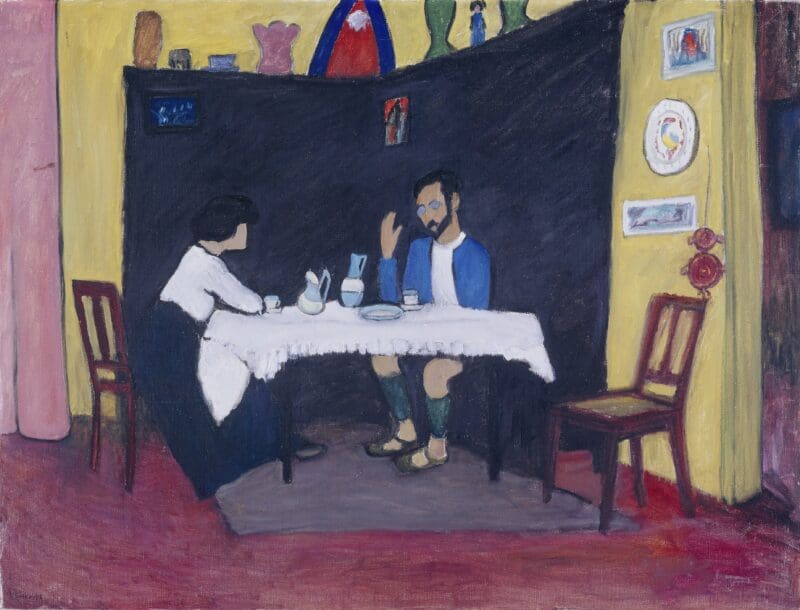
Gabriele Münter, Kandinsky and Erma Bossi at the Table, 1912. Lenbachhaus Munich, Donation Gabriele Münter © DACS 2024
My starter, a square-shaped vegetable terrine looked more Mondrian than Expressionist but the Rhineland dressing lent an appropriate Germanic flavour. Smoked trout, a favourite meal in the land of Gabriele Münter – the Expressionist painter who studied and lived with Kandinsky and co-founded the Blue Rider group – is one of the main art-related dishes.
Other items from the regular non-exhibition menu are also available so vegetarians are not excluded, but whatever your choice one of the sides is unquestionably worth tasting: heritage radishes, gently spicy and peppery, in a milky bed of hyper-whipped vegan feta.
Radishes are so unfairly marginalised but, like the painters in the exhibition, their avant-garde moment has arrived. A black forest mousse with a suggested Riesling pairing rounds off a splendid celebration of cultural gastronomy.
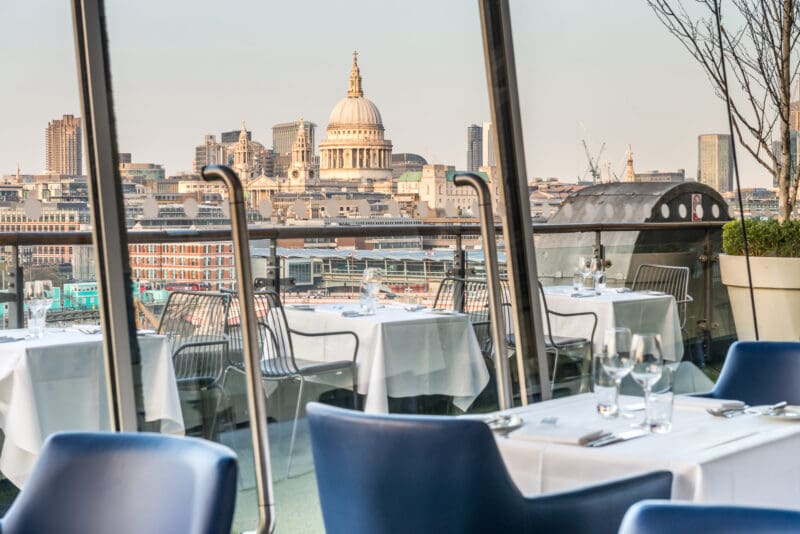
A view from inside Oxo Tower Restaurant of the terrace, the Thames and St Paul’s Cathedral
Oxo Tower Restaurant, the name comes from a brand of beef stock cubes once found on the shelves of most kitchens across the UK, is on the roof-top level of the building in front of it. The main building, originally also an electricity power station, was rebuilt in the late 1920s by the company that makes the stock cubes but the tower was kept intact.
The company shrewdly advertised their product by incorporating the word Oxo into the tower’s windows. Situated about midway between Waterloo Bridge and Blackfriars Bridge, the restaurant enjoys an expansive view of London stretching from St Paul’s in the east over to the Post Office Tower in the north-east. The grand neoclassical building seen on the north side of Blackfriars Bridge, distinguished by its curved frontage, is Unilever House and dates from 1930.
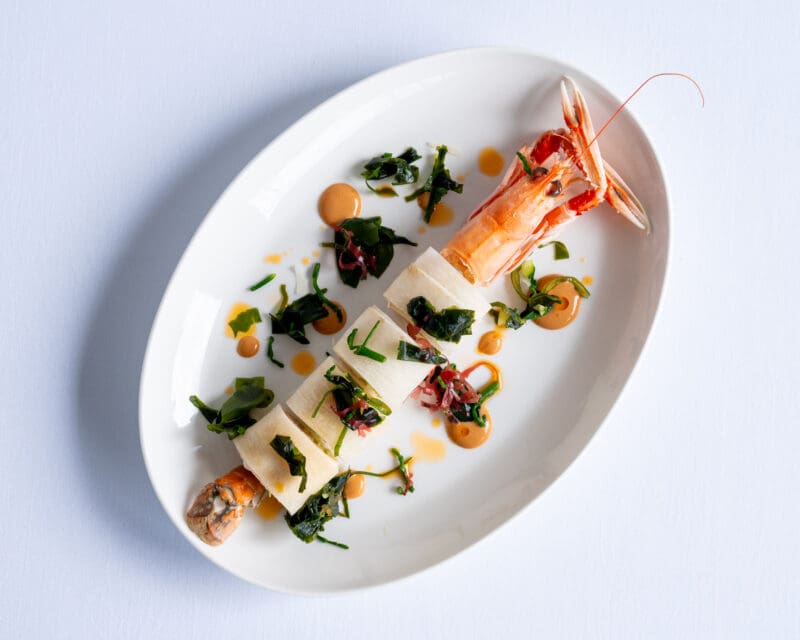
Artfully presented langoustine at Oxo Tower Restaurant
Oxo Tower Restaurant’s menu covers the best of British cuisine: from Orkney scallops to Exmoor caviar, taking in beef from Yorkshire, lettuce from Lancashire and pork from Suffolk. The food is crafted to look gorgeous when it arrives at your table and it seemed a shame to disturb the inventive symmetry of my langoustine starter. A
gain, though, it was a side dish that stole the show – this time slices of orange with fennel that looked to be spiralled, slices of olive and tiny balls of cheese – a triumph of ingenuity. The restaurant’s interior, roomy and filled with natural light, has large Rothko-style artwork on the walls and, weather permitting, there are tables outdoor on the balcony.
The riverside view is stupendous, especially as dusk turns to darkness and red lights on the building cranes on the north side become red candles in the sky. London has never looked so untroubled.
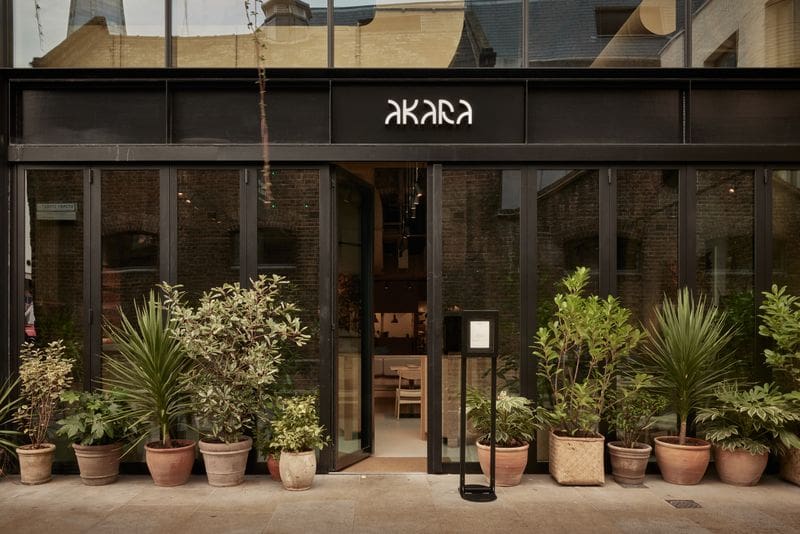
The exterior of Akara near Borough Market
In the 1860s, a railway company serving the southeast extended its line into the heart of London. A new terminal at Cannon St was built and a railway bridge across the Thames to access it. The work required construction of railway arches on the south side of the river and the ground level spaces between them were first used as warehouses.
Subsequently disused, they have been restored and one of them is home to Akara. Its airy frontage, all glass and plants, makes an attractive contrast to the brickwork of the arches and the frenzy of Borough Market. Inside the restaurant, gentle vibes and Afro-beat music make it easy to relax and take in the industrial legacy of the building. The ducts above your head are sand-coloured, an unusual but pleasing touch, and a piece of stunning artwork on the wall defines Akara’s West African identity.
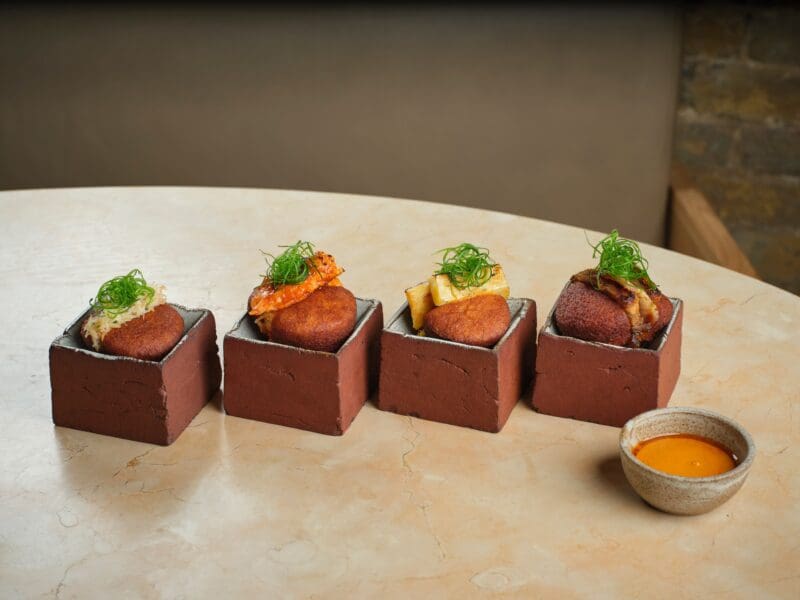
Akaras – small cakes using black-eyed beans, each presented in its own box
Akaras are bean cakes – black-eyed beans in this case – found throughout West Africa, Brazil and the Caribbean. Made from a batter of deep-fried black-eyed beans, previously whisked, and filled with a choice of prawns, celeriac, crab or marinated tomato, they demand to be tasted.
Of the seven main dishes, my friend opted for the Lagos chicken with a coconut sauce and remained silent until the plate was empty because, it was explained afterwards, to talk would have been a distraction from enjoying its sizzling succulence.
Akara’s drink list is far from mediocre and two of the drinks – a vodka and peach cocktail and a non-alcoholic version – make punchy use of scotch bonnet (rated twenty five times stronger than jalapeño chilli peppers on the Scoville scale of spiciness).
Good food and drink and an appreciation of London’s industrial architecture have never been combined so well as at these three restaurants in the heart of London.
by Sean Sheehan
